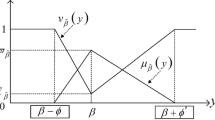Abstract
Consensus measure is an important process for group decision-making. The traditional consensus-evaluation method determines the solution by fuzzy set and cannot treat the negative evidence for membership function. In this paper, we present a method for consensus measure in the risk assessment process by relaxing assumptions about the existing of hesitation situation. First, a new similarity measure of vague sets is introduced. Then, a fuzzy synthetic evaluation method is employed to attain the consensus interval of the group via the agreement matrix. Finally, a real example of risk assessment guided by BS7799 is given to demonstrate our method. The proposed method applies the soft consensus method proposed by Kacprzyk and Fedrizzi, analyzes the variation trend of group consensus using similarity measures of vague sets and consensus index. From numerical illustrations, the usefulness of the proposed method has shown, particularly in a situation with vague and ill-defined data.
Preview
Unable to display preview. Download preview PDF.
Similar content being viewed by others
References
Atanassov, K.: Intuitionistic fuzzy sets. Fuzzy Sets and Systems 20, 87–96 (1986)
Atanassov, K.: Intuitionistic Fuzzy Sets: Theory and Applications. Springer, Heidelberg (1999)
BSI: BS 7799-2:2002, Information Security Management- Part 2: Specification for Information Security Management, Systems, London
Carroll, J.M.: Information Security Risk Management. In: Computer Security Handbook, Wiley, New York (1985)
Chen, S.M.: Measures of similarity between vague sets. Fuzzy Sets and Systems 74, 217–223 (1995)
Chen, S.M.: Measures of similarity between vague sets and elements. IEEE Transactions on System, Man and Cybernetics - Part B, Cybernetics 27, 153–158 (1997)
Chen, S.M.: Analyzing fuzzy system reliability using vague set theory. International Journal pf Applied Science and Engineering 1(1), 82–88 (2003)
Chiclana, F., Herrera, F., Herrera-Viedma, E.: Integrating three representation models in fuzzy multipurpose decision making based on fuzzy preference relations. Fuzzy Sets and Systems 97, 33–48 (1998)
De, S.K., Biswas, R., Roy, A.R.: An application of intuitionistic fuzzy sets in medical diagnosis. Fuzzy Sets and Systems 117, 209–213 (2001)
Gary, S., et al.: Risk Management Guide for Information Technology Systems. In: Special Publication 800-300, National Institute of Standards and Technology (2001)
Gau, W.L., Buehrer, D.j.: Vague sets. IEEE Trans Systems Man Cybernetics 23, 610–614 (1993)
Herrera, F., et al.: A rational consensus model in Group decision making using linguistic assessments. Fuzzy set and Systems 88, 31–49 (1997)
Hwang, C.L., Lin, M.J.: Group Decision Making under Multiple Criteria. Springer, New York (1987)
Kacprzyk, J., Fedrizzi, M.: A soft’ measurement of consensus in the setting of partial (fuzzy) preference. European Journal of Operation Research 34, 316–326 (1988)
Kacprzyk, J., Fedrizzi, M.: Multi-person decision making using fuzzy sets and possibility, pp. 231–241. Kluwer Academic Publishers, Netherlands (1990)
Liang, Z., Shi, P.: Similarity measures on intuitionistic fuzzy sets. Pattern Recognition Letters 24, 2687–2693 (2003)
Li, D., Cheng, C.: New similarity measures of intuitionistic fuzzy sets and application to pattern recognition. Pattern Recognition, Letters 23(1–3), 221–225 (2002)
Szmidt, E., Kacprzyk, J.: Evaluation of agreement in a group of experts via distance between intuitionistic fuzzy preference. International IEEE Symposium “intelligent systems” (2002)
Zadeh, L.A.: A computational approach to fuzzy quantifiers in natural languages. Comput. Math. Appl. 9, 149–184 (1983)
Zimmermann, H.J., Zysno, P.: Decision and evaluations by hierarchical aggregation of information. Fuzzy Sets and Systems 10, 243–260 (1983)
Zwick, R., Carlstein, E., Budescu, D.V.: Measures of similarity among fuzzy concepts: A comparative analysis. Internet. J. Approximate Reasoning 1, 221–242 (1987)
Author information
Authors and Affiliations
Editor information
Editors and Affiliations
Rights and permissions
Copyright information
© 2006 Springer-Verlag Berlin Heidelberg
About this paper
Cite this paper
Lo, CC., Wang, P., Chao, KM. (2006). Solving Consensus Measure of Ambiguous GDM Problems Using Vague Sets – An Application of Risk Assessment. In: Shen, Wm., Chao, KM., Lin, Z., Barthès, JP.A., James, A. (eds) Computer Supported Cooperative Work in Design II. CSCWD 2005. Lecture Notes in Computer Science, vol 3865. Springer, Berlin, Heidelberg. https://doi.org/10.1007/11686699_58
Download citation
DOI: https://doi.org/10.1007/11686699_58
Publisher Name: Springer, Berlin, Heidelberg
Print ISBN: 978-3-540-32969-5
Online ISBN: 978-3-540-32970-1
eBook Packages: Computer ScienceComputer Science (R0)




